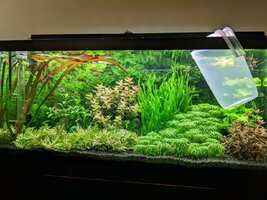If your max accumulation is 21 ppm and you change 50% then you should dose the new incoming water to your max accumulation target. Let's say you remove 50 gallons, then the "new" 50 gallons is dosed to 21 ppm. To look at it another way all new incoming water is dosed to the targeted max accumulation.
This is what I refer to as "target" dosing. No matter how much water is removed, the new incoming water is always dosed to the target.
If you really want to geek out here is something I wrote up about this recently. This is the way I look at my tank and my dosing.
Target Dosing – What does it mean??
For some reason along the way the commonly accepted method of reporting dosing became posting the total ppm of nutrients you dose per week (NO3 : PO4 : K). As shown in the discussion above about accumulation depending on your water change schedule that can mean a lot of different things. So if you compare your dosing to others you may not be comparing apples to apples.
The odd thing to me is that common way we report dosing has little to do with the level of nutrients we would like to see in the water column. Which, if you think about it, is the whole point of dosing, right?
I prefer to look at my tank in terms of what I call “Target Dosing”.
So what does that mean? Instead of thinking in terms of how much you dose per week, instead start thinking in terms of the “Target” ppm you would like to see in the water column. This takes the water change volume and frequency out of the equation.
If we go back to the discussion on accumulation, you may remember that someone saying they dose 20 ppm of NO3 can mean a lot things. At 25% water change that means 80 ppm in the water column, at 50% water change that means 40 ppm in the water column, and at 75% water change that means 26.66 ppm in the water column.
So lets look at this another way. Let’s say my target is 30 ppm of NO3 in the water column. In my tank I change 70 gallons of water at a time. The way I calculate dosing is that I want to raise the “new” incoming 70 gallons of water to my “target” ppm. Here’s the calculation.
View attachment 198877
So why do I prefer to look at my dosing as dosing to a target? Well in my case sometimes I change my water once a week. Sometimes twice a week. Sometimes a full 70 gallons. Sometimes 35 gallons mid week. Makes no difference I keep it simple. If I remove 35 gallons I dose the new 35 gallons to my target. If I change 70 gallons I change the new 70 gallons to my target.
Here’s one more way to look at it. Below are my RO water storage tanks. It’s where I store the water that is pumped up to my tank during a water change. These tanks are constantly kept at the same nutrients levels. So all incoming water is pre dosed to my water column targets.
View attachment 198878
And there is one more advantage. Let’s say I am comparing my dosing to my friend Joe Harvey .
He might tell me he is dosing 28 ppm NO3. But his water change percentage is 90%.
And I might tell him I am dosing 22 ppm NO3. But my water change is 70%
And someone else tells me they are dosing 15 ppp NO3 with a 50% water change.
If we remember our calculation to find the maximum theoretical accumulation (ppm divided by water change percentage), it turns out we are all dosing to reach the same "target".
28 ppm NO3 divided by .90 = 31
22 ppm NO3 divided by .70 = 31
15 ppm NO3 divided by 0.50 = 30.
So to me this is a simpler way to think about dosing that makes it easy to understand what that dosing means. A few years ago I went on a crusade to change the way people report their dosing as their “target”….but it didn’t really catch on. Although I do see a few people here and there that I know now referring to it. So you might notice when I post my parameters I list the “target” ppm. I also convert that to the typical EI equivalent if I was performing the typical 50% water change that most do.
As usual I hope that helps a few people out there and offers another way to think about how you dose your tank.



